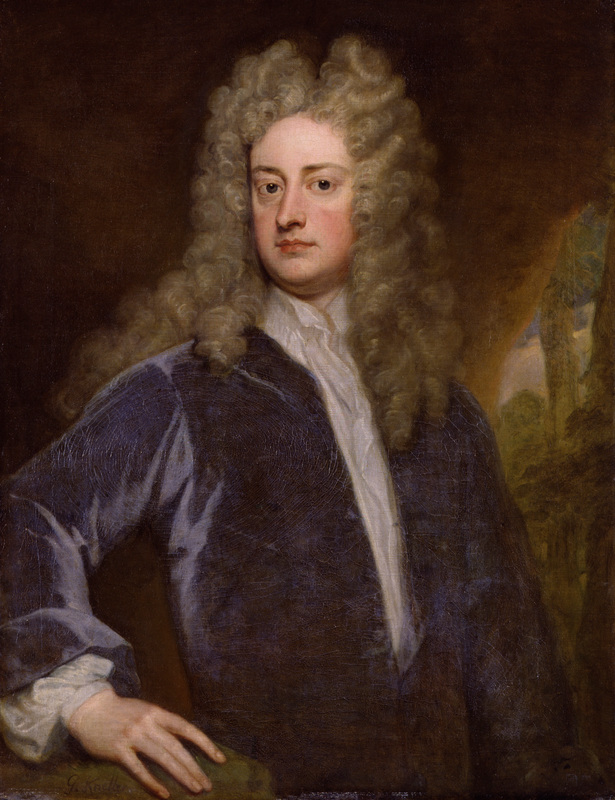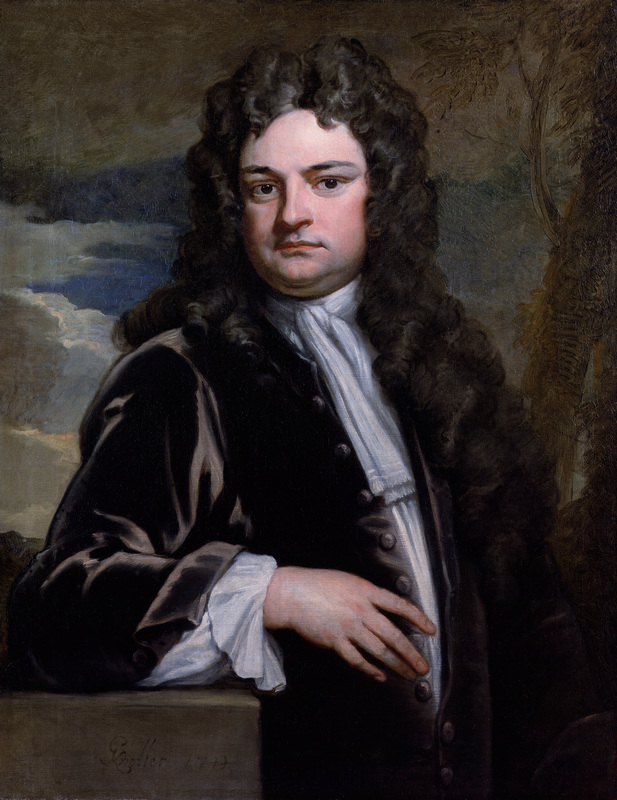Headnote for Joseph Addison and Richard Steele
By
John O'Brien
Joseph Addison (1672-1719) and Richard Steele (1672-1729) lived rich lives on their
own, but here we will briefly talk about them together as a way of introducing the
collaborative journalism for which they are now best remembered, the essay
series The Tatler (1709-1711) and The Spectator (1711-1712).
 Source: Godfrey Kneller, Portrait of Joseph Addison (National Portrait Gallery, UK)Born just a few weeks
apart, Addison and Steele knew each other from the age of thirteen, and they also
overlapped at Oxford (though they attended different colleges, Addison going to
Queen's and Magdelen and Steele to Christ Church and Merton). They crossed paths
again in London in the early part of the eighteenth century; both of them had
political and literary ambitions. By all accounts, Addison and Steele had very
different personalities. Addison had many friends and seems to have been brilliant
at getting influential people to support and help him. But his personal demeanor was
serious and he wrote ambitious poems and the century's most significant verse
tragedy, Cato (1713), a play that is rarely staged now but was a staple of the
repertory for decades. Steele was more a journalist at heart, and his plays are all
comedies (to be sure, Addison wrote a comedy, too, but it was not very successful,
whereas Steele had several hits). And a lot of people seemed to be unable to take
Steele very seriously; he was notorious for running up big debts, and was often
mocked in the public press of the period.
Source: Godfrey Kneller, Portrait of Joseph Addison (National Portrait Gallery, UK)Born just a few weeks
apart, Addison and Steele knew each other from the age of thirteen, and they also
overlapped at Oxford (though they attended different colleges, Addison going to
Queen's and Magdelen and Steele to Christ Church and Merton). They crossed paths
again in London in the early part of the eighteenth century; both of them had
political and literary ambitions. By all accounts, Addison and Steele had very
different personalities. Addison had many friends and seems to have been brilliant
at getting influential people to support and help him. But his personal demeanor was
serious and he wrote ambitious poems and the century's most significant verse
tragedy, Cato (1713), a play that is rarely staged now but was a staple of the
repertory for decades. Steele was more a journalist at heart, and his plays are all
comedies (to be sure, Addison wrote a comedy, too, but it was not very successful,
whereas Steele had several hits). And a lot of people seemed to be unable to take
Steele very seriously; he was notorious for running up big debts, and was often
mocked in the public press of the period.
Surely part of the difference between the two men and the way that they were received by others had to do with issues of class and ethnicity. Steele was Irish, and although he was from a respectable family in Dublin (his father was an attorney) he did not have much of a family network in England to help him make his way in the world. He almost certainly faced his share of the prejudice against Irish people that many English people harbored for centuries. After his time at Oxford (which he left without completing a degree), Steele went into the army, and did well, rising to become a captain. He started writing poetry and drama as a side project while he was still in the military. At some point, though, his military career stalled, and he came to London to work in the government; he got a position at court, and took on the job of editing the official newspaper, the London Gazette. Addison was not from a particularly wealthy or noble family, either, but the Addisons were well-placed in the power structure of the Church of England, the official state church. Addison's father Lancelot was the chaplain of the English garrison at Tangier, in Morocco, and would later become the Dean of the cathedral at Lichfield. One of Addison's brothers became the English governor of Madras, in India. Joseph Addison seems to have been identified early on as someone who would have a significant public career. After finishing his degree at Oxford, he was sent on a grand tour of the continent at government expense, and would go on to be a member of Parliament (he was essentially given a seat there; he did not have to campaign) and a cabinet minister.
Steele left London Gazette and started The Tatler in 1709. This journal, which was published three times a week, was something new and innovative. Rather than focusing on the news, it offered essays on a variety of topics: theater reviews, essays on clothing and manners, and so on. It was fast-paced, entertaining, and in an age when much print publication was bitterly political, was non-partisan. The Tatler was immediately popular. Steele asked Addison and other friends to join him (it was surely hard to come up with enough material on his own), and Addison contributed several dozen essays. The Tatler folded at the start of 1711, but was almost immediately followed by The Spectator. Here Addison took the lead, contributing a larger number of essays than Steele and, most scholars agree, setting the tone for the new journal. The Spectator, which was published every day except Sunday, ran 555 issues, until finally running out of steam.
 Source: Godfrey Kneller, Portrait of Richard Steele (National Portrait Gallery, UK)
Source: Godfrey Kneller, Portrait of Richard Steele (National Portrait Gallery, UK)
Both journals were widely read in their first publication, and perhaps even more so over the course of the next two centuries when they were collected together and bound up as book-length volumes. A set of The Tatlers and The Spectators was something that every middle-class household with aspirations to looking like its members took literature seriously would want to have. These essays were published in that kind of format scores of times in the English-speaking world, their essays often being offered to students as examples of clear, vigorous English prose; they were also translated into most of the European languages. In our time, these essays have become newly relevant as having inaugurated what the sociologist Jürgen Habermas dubbed "the bourgeois public sphere," a domain of society separate from the state or the royal courts where middle class people came together to debate social issues. Even more recently, these short, comparatively informal essays, published frequently, have been compared to blogging. Well, maybe. Whatever the case, the early eighteenth-century journalism of Joseph Addison and Richard Steele remains an entertaining and valuable look into the attitudes, tastes, and styles of their period.
At top: Joseph Addison; below, Richard Steele. Both of these portraits were painted by Godfrey Kneller, as part of a series he did around 1710 of portraits of members of the "Kit-Kat Club," a group of Whig politicians who met for drinking and sociability. Both portraits are now in the National Portrait Gallery, London.